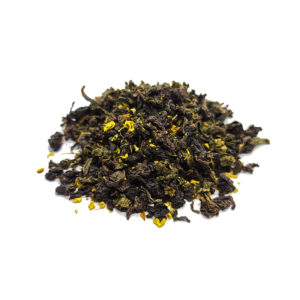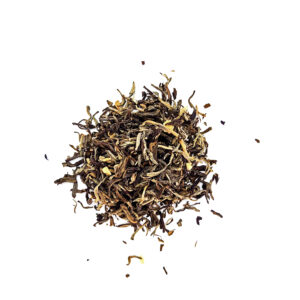
Dark Roast Oolong
$69.95 – $345.95
A remarkable dark roast high mountain oolong from Alishan, with floral, peachy sweetness, clear brew with no bitterness
-
Description
-
Oolong Tea Brewing Instructions
-
Reviews (0)
Taiwan is renowned for its oolong teas, and the Alishan mountain range, located in central Taiwan, is one of its premier tea-producing regions. The high altitude, cool climate, and fertile soils of Alishan contribute to the distinctive flavour profiles of its teas. One of the special offerings from this region is the dark roast Alishan oolong. Here’s an in-depth look:
1. General Characteristics of Alishan Oolong: Oolong teas from Alishan are typically characterized by a creamy body, floral aroma, and a sweet, lingering aftertaste. They are often lightly oxidized, giving them a greenish appearance and a fresh flavour.
2. Dark Roasting Process: A dark roast Alishan oolong undergoes a longer and more intense roasting process than the typical Alishan oolong. This roasting imparts a deeper colour to the leaves and a more complex flavour profile. The tea loses some of its floral notes but gains richer, toasty, and sometimes caramel or chocolaty undertones.
3. Flavour Profile: The flavour of dark roast Alishan oolong can be described as robust with hints of toasted nuts, wood, and sometimes dark fruit. There’s a noticeable depth to the flavour, with the underlying sweetness of the Alishan oolong still shining through.
4. Appearance: The leaves are typically tightly rolled into small balls, which unfurl during brewing, revealing large, whole leaves. Due to the extended roasting, the leaves take on a darker hue compared to lightly oxidized oolongs.
5. Brewing Recommendations: Using freshly boiled water that has cooled slightly (around 85°C to 90°C) is ideal. The tea can be steeped multiple times, with each infusion revealing a slightly different flavour nuance.
6. Terroir Impact: Alishan’s high-altitude environment means that tea plants grow slower, allowing them to accumulate more nutrients and flavour compounds. The frequent mists and cooler temperatures also contribute to the tea’s sweet and smooth character.
7. Economic and Cultural Importance: Alishan oolong, including its dark roast variant, is highly sought after both domestically in Taiwan and internationally. It has played a significant role in promoting Taiwanese tea culture and boosting the local economy.
8. Storage: Due to its roasting level, dark roast Alishan oolong can be stored for longer periods than its lightly oxidized counterpart. In fact, the flavour can even improve and mellow out with time, much like aged teas.
9. Pairing: The rich and toasty flavour of dark roast Alishan oolong pairs well with slightly sweet desserts, roasted meats, and even some cheeses.
Dark Roast Alishan oolong is a testament to the art of tea processing. While the fresh and floral characteristics of Alishan oolong are delightful in their own right, the deeper, more complex flavours achieved through extended roasting offer a different, equally rewarding experience.
Oolong Tea Brewing Instructions
Like most green teas, this one should be steeped in cooler water than black or oolong teas. A temperature of 176°F (80°C) is a good starting point.
- Pour enough boiling water into the empty teapot to fill everyone’s cup. The teapot should NOT contain any tea leaves at this point.
- Pour the water into each cup, filling it to the desired level (usually about 80% to 90% full). This will cool the water from boiling temperature to the desired 80° C (176° F).
- Put about one large teaspoon of tea leaves into the empty teapot for each cup of tea. The teapot I am using comes with an infuser, but if yours doesn’t, you can put the leaves directly in the pot.
- Pour the water in the teacups back into the teapot.
- Let the tea steep for one minute.
- Pour a small amount of tea into the first cup, then pour the same amount into every other cup. Continue filling the cups a little at a time, making sure that each cup contains the same amount of the weaker first pours and the stronger last drops. DO NOT fill one cup completely and then move on to the next cup.
- Continue pouring until the teapot is completely empty. You want the leaves to be as dry as possible to ensure a quality second infusion
- For the second infusion, you do not need to add any fresh leaves. Pour boiling water from your kettle directly into the cups, wait about 30 seconds, then pour the water onto the leaves in the teapot. This will ensure a higher water temperature than you used for the first infusion.
- Let the tea steep 20 to 30 seconds, then pour the brew into the cups, alternating cups as before. Distribute all the liquid, leaving the leaves as dry as possible.
- For the third infusion, repeat the instructions for the second, but steep for one to three minutes, depending on the quality of the tea you are using.
- Whether you want a fourth infusion will also depend on the quality of your tea. Try it once and see how it tastes.
Only logged in customers who have purchased this product may leave a review.



There are no reviews yet.